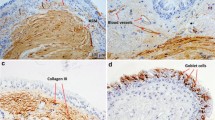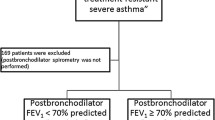Abstract
Asthma is generally characterized by fully reversible airway obstruction. However, a significant proportion of asthma patients demonstrate an incomplete reversibility of airway obstruction (IRAO) despite optimal treatment and the absence of a significant smoking history. Such partially irreversible airway obstruction may be due to residual airway inflammation, particularly of the eosinophilic type, and structural changes. Risks factors for IRAO include reduced pulmonary function early in life, frequent exacerbations, smoking, continuing exposure to a sensitizing agent, and adult-onset asthma. IRAO is associated with increased disease severity and increased asthma-related morbidity and mortality. Optimal asthma control, including prevention of asthma exacerbations, smoking avoidance, and sufficient anti-inflammatory therapy, should be implemented in an effort to avoid an accelerated decline in lung function and the development or worsening of IRAO.
Similar content being viewed by others
References and Recommended Reading
Global Initiative for Asthma (GINA): GINA Report, Global Strategy for Asthma Management and Prevention. Available at http://www.ginasthma.org/Guidelineitem.asp??l1=2&l2=1&intId=60. Accessed January 5, 2009.
Wenzel SE: Asthma: defining of the persistent adult phenotypes. Lancet 2006, 368:804–813.
Boulet LP, Becker A, Bérubé D, et al.: Summary of recommendations from the Canadian Asthma Consensus Report, 1999. Canadian Asthma Consensus Group. CMAJ 1999, 161:S1–S12.
Brown PJ, Greville HW, Finucane KE: Asthma and irreversible airflow obstruction. Thorax 1984, 39:131–136.
Boulet LP, Turcotte H, Turcot O, Chakir J: Airway inflammation in asthma with incomplete reversibility of airflow obstruction. Respir Med 2003, 97:739–744.
Boulet L, Belanger M, Carrier G: Airway responsiveness and bronchial-wall thickness in asthma with or without fixed airflow obstruction. Am J Respir Crit Care Med 1995, 152:865–871.
Ulrik CS, Backer V: Nonreversible airflow obstruction in life-long nonsmokers with moderate to severe asthma. Eur Respir J 1999, 14:892–896.
ten Brinke A: Risk factors associated with irreversible airflow limitation in asthma. Curr Opin Allergy Clin Immunol 2008, 8:63–69.
ten Brinke A, Zwinderman AH, Sterk PJ, et al.: Factors associated with persistent airflow limitation in severe asthma. Am J Respir Crit Care Med 2001, 164:744–748.
Guerra S, Sherrill DL, Kurzius-Spencer M, et al.: The course of persistent airflow limitation in subjects with and without asthma. Respir Med 2008, 102:1473–1482.
Hudon C, Turcotte H, Laviolette M, et al.: Characteristics of bronchial asthma with incomplete reversibility of airflow obstruction. Ann Allergy Asthma Immunol 1997, 78:195–202.
Loren ML, Leung PK, Cooley RL, et al.: Irreversibility of obstructive changes in severe asthma in childhood. Chest 1978, 74:126–129.
Vonk JM, Jongepier H, Panhuysen CI, et al.: Risk factors associated with the presence of irreversible airflow limitation and reduced transfer coefficient in patients with asthma after 26 years of follow up. Thorax 2003, 58:322–327.
Lee JH, Haselkorn T, Borish L, et al.: Risk factors associated with persistent airflow limitation in severe or difficult-to-treat asthma: insights from the TENOR study. Chest 2007, 132:1882–1889.
Bergeron C, Boulet LP: Structural changes in airway diseases: characteristics, mechanisms, consequences, and pharmacologic modulation. Chest 2006, 129:1068–1087.
Finucane KE, Greville HW, Brown PJ: Irreversible airfl ow obstruction. Evolution in asthma. Med J Aust 1985, 142:602–604.
Gelb AF, Zamel N: Unsuspected pseudophysiologic emphysema in chronic persistent asthma. Am J Respir Crit Care Med 2000, 162:1778–1782.
Boulet L, Becker A, Bowie D, et al.: Implementing practice guidelines: a workshop on guidelines dissemination and implementation with a focus on asthma and COPD. Can Respir J 2006, 13(Suppl A):5–47.
Barnes PJ, Ito K, Adcock IM: Corticosteroid resistance in chronic obstructive pulmonary disease: inactivation of histone deacetylase. Lancet 2004, 363:731–733.
Bumbacea D, Campbell D, Nguyen L, et al.: Parameters associated with persistent airflow obstruction in chronic severe asthma. Eur Respir J 2004, 24:122–128.
Jang AS, Lee JH, Park SW, et al.: Risk factors related to fi xedairway obstruction in patients with asthma after antiasthma treatment. Ann Allergy Asthma Immunol 2007, 99:408–412.
Covar RA, Spahn JD, Murphy JR, Szefler SJ: Progression of asthma measured by lung function in the childhood asthma management program. Am J Respir Crit Care Med 2004, 170:234–241.
van Veen I, ten Brinke A, Sterk PJ, et al.: Exhaled nitric oxide predicts lung function decline in difficult-to-treat asthma. Eur Respir J 2008, 32:344–349.
Fabbri LM, Romagnoli M, Corbetta L, et al.: Differences in airway inflammation in patients with fixed airflow obstruction due to asthma or chronic obstructive pulmonary disease. Am J Respir Crit Care Med 2003, 167:418–424.
ten Brinke A, Zwinderman AH, Sterk PJ, et al.: “Refractory” eosinophilic airway inflammation in severe asthma: effect of parenteral corticosteroids. Am J Respir Crit Care Med 2004, 170:601–605.
Jeffery PK: Differences and similarities between chronic obstructive pulmonary disease and asthma. Clin Exp Allergy 1999, 29(Suppl 2):14–26.
Mauad T, Dolhnikoff M: Pathologic similarities and differences between asthma and chronic obstructive pulmonary disease. Curr Opin Pulm Med 2008, 14:31–38.
Lazaar AL, Panettieri RA Jr: Is airway remodeling clinically relevant in asthma? Am J Med 2003, 115:652–659.
Ward C, Johns DP, Bish R, et al.: Reduced airway distensibility, fixed airflow limitation, and airway wall remodeling in asthma. Am J Respir Crit Care Med 2001, 164:1718–1721.
Tillie-Leblond I, De Blic J, Jaubert F, et al.: Airway remodeling is correlated with obstruction in children with severe asthma. Allergy 2008, 63:533–541.
Boulet LP, Lemiere C, Archambault F, et al.: Smoking and asthma: clinical and radiologic features, lung function, and airway inflammation. Chest 2006, 129:661–668.
Humbles AA, Lloyd CM, McMillan SJ, et al.: A critical role for eosinophils in allergic airways remodeling. Science 2004, 305:1776–1779.
Lemiere C, Ernst P, Olivenstein R, et al.: Airway inflammation assessed by invasive and noninvasive means in severe asthma: eosinophilic and noneosinophilic phenotypes. J Allergy Clin Immunol 2006, 118:1033–1039.
Tschumperlin DJ, Drazen JM: Chronic effects of mechanical force on airways. Annu Rev Physiol 2006, 68:563–583.
Holgate ST, Davies DE, Lackie PM, et al.: Epithelial-mesenchymal interactions in the pathogenesis of asthma. J Allergy Clin Immunol 2000, 105:193–204.
Jongepier H, Boezen HM, Dijkstra A, et al.: Polymorphisms of the ADAM33 gene are associated with accelerated lung function decline in asthma. Clin Exp Allergy 2004, 34:757–760.
Morgan WJ, Stern DA, Sherrill DL, et al.: Outcome of asthma and wheezing in the fi rst 6 years of life: follow-up through adolescence. Am J Respir Crit Care Med 2005, 172:1253–1258.
Stern DA, Morgan WJ, Wright AL, et al.: Poor airway function in early infancy and lung function by age 22 years: a non-selective longitudinal cohort study. Lancet 2007, 370:758–764.
Sears MR, Greene JM, Willan AR, et al.: A longitudinal, population-based, cohort study of childhood asthma followed to adulthood. N Engl J Med 2003, 349:1414–1422.
Phelan PD, Robertson CF, Olinsky A: The Melbourne Asthma Study: 1964–1999. J Allergy Clin Immunol 2002, 109:189–194.
Marossy AE, Strachan DP, Rudnicka AR, Anderson HR: Childhood chest illness and the rate of decline of adult lung function between ages 35 and 45 years. Am J Respir Crit Care Med 2007, 175:355–359.
de Marco R, Marcon A, Jarvis D, et al.: Prognostic factors of asthma severity: a 9-year international prospective cohort study. J Allergy Clin Immunol 2006, 117:1249–1256.
Rasmussen F, Taylor DR, Flannery EM, et al.: Risk factors for airway remodeling in asthma manifested by a low postbronchodilator FEV1/vital capacity ratio: a longitudinal population study from childhood to adulthood. Am J Respir Crit Care Med 2002, 165:1480–1488.
Bai TR, Vonk JM, Postma DS, Boezen HM: Severe exacerbations predict excess lung function decline in asthma. Eur Respir J 2007, 30:452–456.
O’Byrne PM, Pedersen S, Lamm CJ, et al.; START Investigators Group: Severe exacerbations and decline in lung function in asthma. Am J Respir Crit Care Med 2009, 179:19–24.
Gautrin D, Boulet LP, Boutet M, et al.: Is reactive airways dysfunction syndrome a variant of occupational asthma? J Allergy Clin Immunol 1994, 93:12–22.
Anees W, Moore VC, Burge PS: FEV1 decline in occupational asthma. Thorax 2006, 61:751–755.
Lemiere C, Boulet LP: Cigarette smoking and asthma: a dangerous mix. Can Respir J 2005, 12:79–80.
Thomson NC, Chaudhuri R, Livingston E: Asthma and cigarette smoking. Eur Respir J 2004, 24:822–833.
St-Laurent J, Bergeron C, Page N, et al.: Influence of smoking on airway inflammation and remodelling in asthma. Clin Exp Allergy 2008, 38:1582–1589.
Chalmers GW, Macleod KJ, Little SA, et al.: Influence of cigarette smoking on inhaled corticosteroid treatment in mild asthma. Thorax 2002, 57:226–230.
Chaudhuri R, Livingston E, McMahon AD, et al.: Cigarette smoking impairs the therapeutic response to oral corticosteroids in chronic asthma. Am J Respir Crit Care Med 2003, 168:1308–1311.
Goksor E, Amark M, Alm B, et al.: The impact of pre- and post-natal smoke exposure on future asthma and bronchial hyper-responsiveness. Acta Paediatr 2007, 96:1030–1035.
Lange P, Parner J, Vestbo J, et al.: A 15-year follow-up study of ventilatory function in adults with asthma. N Engl J Med 1998, 339:1194–1200.
Burrows B, Bloom JW, Traver GA, Cline MG: The course and prognosis of different forms of chronic airways obstruction in a sample from the general population. N Engl J Med 1987, 317:1309–1314.
ten Brinke A, van Dissel JT, Sterk PJ, et al.: Persistent airflow limitation in adult-onset nonatopic asthma is associated with serologic evidence of Chlamydia pneumoniae infection. J Allergy Clin Immunol 2001, 107:449–454.
Boulet LP, Des Cormiers A: The link between obesity and asthma: a Canadian perspective. Can Respir J 2007, 14:217–220.
Boulet LP, Hamid Q, Bacon SL, et al.: Symposium on obesity and asthma-November 2, 2006. Can Respir J 2007, 14:201–208.
Parameswaran K, Todd DC, Soth M: Altered respiratory physiology in obesity. Can Respir J 2006, 13:203–210.
Miranda C, Busacker A, Balzar S, et al.: Distinguishing severe asthma phenotypes: role of age at onset and eosinophilic inflammation. J Allergy Clin Immunol 2004, 113:101–108.
Backman KS, Greenberger PA, Patterson R: Airways obstruction in patients with long-term asthma consistent with ‘irreversible asthma’. Chest 1997, 112:1234–1240.
Barnes PJ: Mechanisms in COPD: differences from asthma. Chest 2000, 117:10S–14S.
The ENFUMOSA cross-sectional European multicentre study of the clinical phenotype of chronic severe asthma. European Network for Understanding Mechanisms of Severe Asthma. Eur Respir J 2003, 22:470–477.
Hansen EF, Phanareth K, Laursen LC, et al.: Reversible and irreversible airflow obstruction as predictor of overall mortality in asthma and chronic obstructive pulmonary disease. Am J Respir Crit Care Med 1999, 159:1267–1271.
Panizza JA, James AL, Ryan G, et al.: Mortality and airflow obstruction in asthma: a 17-year follow-up study. Intern Med J 2006, 36:773–780.
Mauad T, Bel EH, Sterk PJ: Asthma therapy and airway remodeling. J Allergy Clin Immunol 2007, 120:997–1009.
Dijkstra A, Vonk JM, Jongepier H, et al.: Lung function decline in asthma: association with inhaled corticosteroids, smoking and sex. Thorax 2006, 61:105–110.
Green RH, Brightling CE, McKenna S, et al.: Asthma exacerbations and sputum eosinophil counts: a randomised controlled trial. Lancet 2002, 360:1715–1721.
Jayaram L, Pizzichini MM, Cook RJ, et al.: Determining asthma treatment by monitoring sputum cell counts: effect on exacerbations. Eur Respir J 2006, 27:483–494.
Cox G, Thomson NC, Rubin AS, et al.: Asthma control during the year after bronchial thermoplasty. N Engl J Med 2007, 356:1327–1337.
Author information
Authors and Affiliations
Corresponding author
Rights and permissions
About this article
Cite this article
Boulet, LP. Irreversible airway obstruction in asthma. Curr Allergy Asthma Rep 9, 168–173 (2009). https://doi.org/10.1007/s11882-009-0025-2
Published:
Issue Date:
DOI: https://doi.org/10.1007/s11882-009-0025-2




